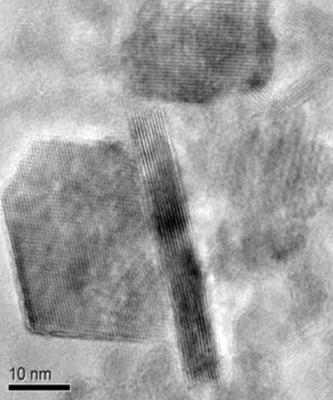Lithium batteries' tendency to occasionally catch on fire (an occurrence known as thermal runaway) is well documented, and may occur when the batteries overheat or cycle rapidly. Researchers from the University of Illinois at Chicago College of Engineering report that graphene may help with this disturbing issue.
 Lithium cobalt oxide particles coated in graphene. Image by UIC
Lithium cobalt oxide particles coated in graphene. Image by UIC
Conditions such as rapid cycling or charging and discharging, and high temperatures in the battery can cause the cathode inside the battery â which in the case of most lithium batteries is a lithium-containing oxide, usually lithium cobalt oxide â to decompose and release oxygen. If the oxygen combines with other flammable products given off through decomposition of the electrolyte under high enough heat, spontaneous combustion can occur.
It was reported by the team that graphene may provide a perfect solution to this problem. Shahbazian-Yassar and his colleagues previously had used graphene to help modulate lithium buildup on electrodes in lithium metal batteries.
Shahbazian-Yassar and his colleagues knew that graphene sheets are impermeable to oxygen atoms. Shahbazian-Yassar and Soroosh Sharifi-Asl, a graduate student in mechanical and industrial engineering at UIC and lead author of the paper, thought that if they wrapped very small particles of the lithium cobalt oxide cathode of a lithium battery in graphene, it might prevent oxygen from escaping.
First, the researchers chemically altered the graphene to make it electrically conductive. Next, they wrapped the tiny particles of lithium cobalt oxide cathode electrode in the conductive graphene.
When they looked at the graphene-wrapped lithium cobalt oxide particles using electron microscopy, they saw that the release of oxygen under high heat was reduced significantly compared with unwrapped particles.
Next, they bound together the wrapped particles with a binding material to form a usable cathode, and incorporated it into a lithium metal battery. When they measured released oxygen during battery cycling, they saw almost no oxygen escaping from cathodes even at very high voltages. The lithium metal battery continued to perform well even after 200 cycles.
The wrapped cathode battery lost only about 14% of its capacity after rapid cycling compared to a conventional lithium metal battery where performance was down about 45% under the same conditions, Sharifi-Asl said.
Graphene is the ideal material for blocking the release of oxygen into the electrolyte, Shahbazian-Yassar said. It is impermeable to oxygen, electrically conductive, flexible, and is strong enough to withstand conditions within the battery. It is only a few nanometers thick so there would be no extra mass added to the battery. Our research shows that its use in the cathode can reliably reduce the release of oxygen and could be one way that the risk for fire in these batteries â which power everything from our phones to our cars â could be significantly reduced.